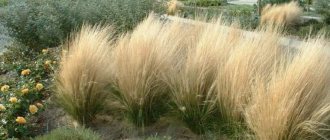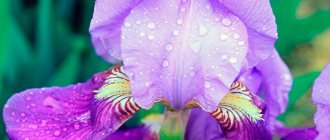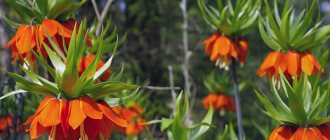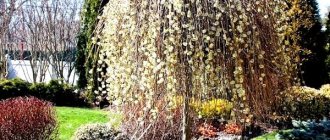Updated: 06/18/2021 16:19:02
Moss is considered the most ancient plant in the world, which appeared 1,000,000 years ago. In the modern classification of mosses, there are 18,000 species. The size of the moss is very small - from 3 mm to 15 cm, some types - 40 cm. Many are perplexed why moss is needed on the site, because you can plant beautiful flowers? This opinion is fundamentally wrong, since soft perfection can create an exclusive image. For example, in the 14th century in Japan, the Saihoji moss garden was created, which still delights its visitors with the beauty.
Types of moss for landscaping
Among the variety of bryophytes, there are also very small varieties that it would be a shame not to pay attention to.
- Hypnotic.
Recommended for use in creating moss lawns and for covering joints in paved paths. Green moss can be grown both on the ground and on trees and rocks.
- Leucobria
. Light green bryophyte grows in tussocks. It is recommended to grow in partial shade, as it can only tolerate sun for a couple of hours a day.
- Dicranum.
The height of the narrow shoots is 4 cm. Dicranum varieties differ in color. In landscape design they are used to decorate concrete walls and rocky soils.
- Kukushkin flax.
Ideal for creating a Japanese style garden. Prefers marshy areas. The beauty of cuckoo flax is simply amazing - if you look at the stems from above, they look like stars. Plant height up to 40 cm.
- Sphagnum
. Suitable for decorating the banks of artificial reservoirs, since sphagnum can only show itself in all its glory in wetlands. A mossy carpet in various shades of green and red will fit perfectly into the garden design. The hummocks look beautiful on stones and on narrow strips of land.
- Thuidium (fern)
. The shape resembles splayed thuja shoots. Due to its carved shape, it is often called a fern. Grows well in the shade with high humidity.
Benefits and harms
The presence of moss on a personal plot, which is classified as aggressor plants, has its certain advantages and disadvantages. The benefits of moss are:
The latter is partly controversial, since it is necessary to properly plan the landscape design, one of the elements of which will be all kinds of stumps, fallen logs and large stones, densely covered with a carpet of green emerald moss.
At the same time, it is necessary to take into account the harm of this weed. First of all, this is the consumption of useful microelements from the soil, which are intended for vegetables and fruits grown in the garden. As a result, productivity decreases, and the gardener has to constantly add various fertilizers to the soil, which leads to a significant increase in the cost of running a household plot.
The weed disrupts the processes occurring inside the soil, which has a bad effect on both the structure of the soil and its fertility indicators. It is impossible to solve such problems simply by adding additional fertilizers. To remove moss, a gardener will need to constantly dig up the soil, which makes caring for the garden much more difficult.
The use of bryophytes in landscaping
Moss is similar to thick grass and can fill horizontal and vertical surfaces. Bryophytes require pruning as they grow to the sides. In landscape design, moss has found application for design and decoration:
- lawns, lawns;
- garden sculptures;
- decorating paved paths;
- shoreline of a reservoir;
- phytowalls;
- rock gardens;
- flower beds;
- rockeries.
With Japanese, landscape and retro landscaping styles, moss is a must. Thanks to the green carpet, an atmosphere of unity with nature is created.
Bryophytes perform not only a decorative role; if you plant moss in a waterlogged area, the plant will regulate the water balance of the area, absorbing excess moisture. In addition, by growing in a dense carpet, bryophytes prevent soil erosion and blowing. In addition, moss can grow in areas that are completely unsuitable for other plants.
Points to consider
As noted earlier, moss is a fairly moisture-loving plant, and its use in areas where sunlight predominates throughout the day is not rational. The fact is that using it in the form of mulching garden crops planted in open areas will require additional watering. Because moss not only absorbs water well, but can also quickly evaporate it. Besides:
- Promotes soil oxidation, as it contains organic acids, and some plants simply cannot grow in it.
- If you use moss as mulching, but for it to have a long period of action, you must at least use a layer of at least 10-15 centimeters. This mainly applies to lining around fruit trees.
- For mulching, you need to take dry moss, which is pre-dried. When dry, it can be stored in ordinary linen or paper bags.
To summarize, we can say that using moss in your garden can bring many benefits to plants, and if you use it as landscaping for your summer cottage, moss will become an effective decorative element that will bring joy with its beauty for many years.
Source of the article: https://domopravitelnitsa.com/sad-i-ogorod/5-sposobov-ispolzovat-lesnoy-moh-dlya-ogoroda.html
Moss in landscape design
There are many ways to use moss in landscaping.
Decoration of the coastline of an artificial pond
To decorate the banks, it is better to choose different varieties of moss; this design will attract the eye. The placement of bryophytes should be close to each other so that no joints are visible. If you cannot create a seamless carpet, the joints can be filled with pine needles and pebbles.
Creating a swamp on the site
Sphagnum, if planted at a level with water, will create the impression of a decorative swamp on the site. It is advisable to use varieties with different colors.
Small architectural forms decorated with moss
Sculptures on the site look more interesting if they are decorated with moss. Depending on the idea, small architectural forms can be partially or completely covered with moss. With the help of moss, geometric concrete textures have a softer transition.
You can decorate any stone sculpture with bryophytes. To create a truly masterpiece, you need to adhere to certain rules:
- The sculpture that was chosen for decoration with moss should not be located in the sun, since bryophytes love shade and humidity.
- Moss will only grow on rough surfaces. Therefore, before planting the plants, the surface of the sculpture will have to be treated with an abrasive material.
- Only 50% of the product can be decorated with moss, since a sculpture completely covered with greenery will look like an unkempt object.
By adhering to the rules, the site will be the envy of your neighbors.
Moss garden or mossy meadow
A lawn covered with moss looks aesthetically pleasing. Such a garden nourishes the soil with nutrients and retains moisture.
If a large area is allocated for planting moss, it is better to plant it with different shades of mosses. Moss can be planted in lines, in a dense carpet, or in a checkerboard pattern.
Decorating paths and paved paths with moss
The technique of decorating the seams between slabs with moss is appropriate in various styles of landscape design.
Moss is not only appropriate when filling the space between slabs, but bryophytes beautifully frame garden paths.
Green roofs
By placing moss on the roof you can not only visually improve the landscape, but also make the recreation area cooler. Such a roof does not require maintenance, only in the autumn you will have to remove fallen leaves from the trees from the surface.
Effective prevention
It is much easier to prevent the appearance of moss on your garden plot than to subsequently wonder how to get rid of moss in your garden beds. First of all, the gardener needs to solve problems with soil depletion and normalize its chemical composition, eliminating high soil moisture.
Experienced summer residents know why moss appears on the site and how to deal with it:
Significant difficulties arise in the fight against moss in the shade of large trees and garden buildings. It is impossible to provide high-quality lighting in such areas. Various plants can help, including bluegrass, ferns, fescue and bentgrass. Here you can also create a flower bed or flower garden with crops that do well and grow quickly even with a lack of sunlight.
Getting rid of moss on your garden plot is possible only with an integrated approach, when the gardener mechanically cleans the trees and soil of this weed and treats problem beds with strong chemicals. At the same time, appropriate preventive procedures are carried out, including eliminating high acidity and ensuring high-quality drainage, which prevents excessive soil moisture. By properly planning such work, knowing what harm this weed causes to the garden, you can completely clear the garden of moss, subsequently eliminating its appearance on the site.
Source
How to prepare moss for growing in the garden
Rules for harvesting bryophytes for subsequent cultivation on the site:
- When harvesting bryophytes, you should know that he will have to create similar conditions on the site, otherwise the moss will not grow. For example, moss taken from a tree will grow only on the tree, and a plant taken from the ground will take root only on the soil.
- To prepare the material, you will have to cut off some moss with a garden spatula. When harvesting, it is imperative to remove the moss and the substrate in which it grew. This measure will improve the plant’s adaptation to new conditions.
- Mature fragments are suitable for harvesting.
- Bryophytes grow best in partial shade, in a humid environment; such conditions help to obtain rich colors. The sun's rays can hit mosses only in the morning and evening. This will make the color of the bryophytes even brighter.
Before planting in a permanent place, the collected material is cleaned of leaves and other debris.
Why moss grows on a personal plot - reasons
Moss is a perennial green plant and the oldest on Earth. They can be found on all continents, and even in Antarctica. It has no flowers, roots or conducting system. Mosses reproduce by spores that mature in sporangia, a kind of capsule. As the capsules ripen, they burst and the spores are carried by the wind over considerable distances. The spores are so light that they can fly several kilometers. And where there are conditions for spores to germinate, that’s where they begin to grow.
Insidious vegetation may not appear on the site if you know the reasons why it suddenly appears on the site and take appropriate measures in time.
Growing moss from the garden
It is better to choose autumn for planting; the probability of survival during this period is 100%. Bryophytes can be grown on artificial and natural stones, especially if they have a porous surface.
Choosing a landing site
Shady places contain high moisture. These areas are considered ideal for growing moss.
Bryophytes can be used to decorate rocky soils, stones, and plant along garden paths. Moss on the lawn will highlight the beauty of trees and shrubs. But the plant will not grow without care. If the soil is waterlogged, mold will develop on the surface of the moss. As a result of damage, you will have to wipe it with a damp cloth. If such measures are not enough, you need to remove the area affected by mold with a spatula or knife.
The soil
A high pH level is not entirely suitable for mosses, although even in such soil the crop will not die. It is advisable to choose neutral indicators. For planting, you can buy moss or collect it in the forest. However, it is worth remembering that some types of moss are protected, so collecting them may be illegal.
Planting moss
If, when collecting a crop, small areas of a huge colony were taken, it will be easier to root them in the garden.
- To prepare a nutrient solution, take 2 cups of kefir or yogurt, mix with crushed moss - 1 cup. Apply the mixture to the area where the moss will be planted.
- The moss is placed in water for a day so that it is saturated with moisture. Then it must be planted in moist soil.
- Plantings need to be watered. For 2 months - every day, then - I focus on the weather.
Depending on where the moss is planted depends on how quickly it takes root. Too open areas are not an option, as the moss will fade in the sun.
The best place for planting is on the western or northern part of the site.
Description of the weed
This plant, which covers the ground with a thick carpet, can appear on the bark of fruit trees, the roofs of private houses, and the walls of various outbuildings on a personal plot. This weed is characterized by its growth rate, is resistant to bacteria, rot, chemicals, can withstand prolonged drought and even grow through asphalt.
It is extremely difficult to combat moss on the site, which is explained by the vitality of this plant.
It is necessary to decide why moss appears in the beds and how to get rid of this weed in the garden. Experts identify several reasons for the appearance of unwanted vegetation on a personal plot:
Frequent excessive watering or high groundwater levels lead to an increase in soil moisture, which stimulates the active reproduction of moss. Solving problems with improper irrigation of beds in a summer cottage is not difficult. But lowering the groundwater level underground is extremely difficult.
The gardener needs to carry out drainage or add additional turf, which will remove moss and other weeds.
It has been noted that numerous types of moss prefer soil with high acidity, which contributes to waterlogging in the garden. Improper soil composition not only leads to the development of various forms of this weed, but also significantly worsens the yield of grown vegetables and fruits. It would not be superfluous to carry out an appropriate chemical examination of the soil, establishing its parameters, followed by adding lime and other agrochemicals to the soil.
How to care for moss
A healthy plant, impressive in its beauty, can only be obtained with proper care. Maintaining moisture is important for good development. However, waterlogging will have a bad effect on the crop. For better growth, it is necessary to feed the moss with fertilizers.
Trimming
If the moss grows lushly in one part of the area and dries out in another, it means it’s time to trim. Thanks to the formation of the bushes, they will be green and bright. If bald spots form, they must be replaced with new plants.
Moss will decorate the area throughout the year and delight the eye with pleasant greenery, especially since it does not require frequent watering. Maintenance is also not difficult.
How to get rid of moss on a site: the most effective way
When the question arises of how to get rid of moss on a site, the most effective approach is not to destroy it at any cost, but to understand, so to speak, the life philosophy of these amazing organisms.
Moss in beds or on trees in the garden evokes ambivalent feelings. On the one hand - aesthetic pleasure. Mosses are beautiful, and many people try to decorate their areas with them. But on the other hand, the possessive notes of the summer resident’s soul are triggered - someone is trying to settle in the garden without permission and deprive their favorite strawberry bushes and other cultivated plants of food! Let's try to figure out whether this perennial plant can be considered a weed and how to deal with it.
Moss graffiti in the garden: creating compositions
Bryophytes are grateful plants with which you can create works of art. To make your dreams come true, use a simple recipe.
You need to take a blender and place several pillows of moss in it. Then add 1 cup of water, half a cup of kefir, 1 cup of hydrogel for plants to the crushed bryophyte to thicken the mixture. Nothing will work without him. Mix all ingredients. Then, on the surface chosen for planting moss (large stones, brickwork, concrete wall), you need to put a stencil and apply the mixture in a thick layer using a brush.
Within 14 days, it is recommended to spray the plantings more often so that the spores begin to develop. In a month you will be pleased with the results.
Moss is a fan of shaded and damp places. Due to the fact that few people encounter moss in life, therefore there is little knowledge about this amazing plant. In ancient times, moss was used as a medical dressing. Until now, many home owners use moss to insulate their homes. In addition, bryophytes are an excellent material for creating compositions in landscape design.
What is it about?
Man has always tried to use the gifts of nature as widely as possible. This is how he treated sphagnum moss, which was named by the ancient Greeks. Translated, its name means “sponge” and it is not surprising, because this plant absorbs 25 times more water than cotton wool.
Sphagnum looks like a very beautiful grass - bright green in color, pleasant smell and delicate light green color, which turns almost white after drying. This plant has no roots. The lower part of the moss dies, turning into peat and not rotting. Sphagnum moss is mainly used in gardening and floriculture. It serves a person as an excellent fertilizer, and also gives the opportunity to grow flowers in the most unusual and unexpected places. But this is far from the point where peat moss is still used.











